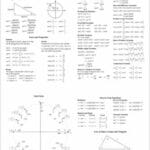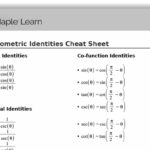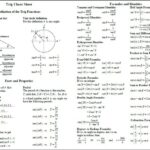Trig identities. Essential for calculus, precalculus, and even physics, but often a source of frustration. This guide, combined with our downloadable trig identities cheat sheet, provides clear explanations, step-by-step examples, and practical applications to help you conquer these crucial formulas. Download your free copy (PDF and Google Slides) now!
Essential Trig Identities: Your Comprehensive Guide
Why are trig identities so important? They simplify complex expressions, unlock equation solutions, and are fundamental to fields like engineering and physics. This guide acts as your personal tutor, breaking down each identity category and demonstrating its use.
Categories of Trig Identities
Reciprocal Identities
These define relationships between trigonometric functions:
- csc θ = 1/sin θ: Cosecant is the reciprocal of sine.
- sec θ = 1/cos θ: Secant is the reciprocal of cosine.
- cot θ = 1/tan θ: Cotangent is the reciprocal of tangent.
These are straightforward and frequently used in simplifications.
Quotient Identities
These define tangent and cotangent in terms of sine and cosine:
- tan θ = sin θ / cos θ: Tangent is sine divided by cosine.
- cot θ = cos θ / sin θ: Cotangent is cosine divided by sine.
These bridge the gap between sine/cosine and tangent/cotangent.
Pythagorean Identities
Derived from the Pythagorean theorem, these are cornerstones of trigonometry:
- sin²θ + cos²θ = 1: This foundational identity connects sine and cosine.
- 1 + tan²θ = sec²θ: Relates tangent and secant.
- 1 + cot²θ = csc²θ: Links cotangent and cosecant.
These are essential for solving trigonometric equations and simplifying expressions.
Co-function Identities
These demonstrate the relationships between complementary angles:
- sin(π/2 – θ) = cos θ: Sine of an angle is the cosine of its complement.
- cos(π/2 – θ) = sin θ: Cosine of an angle is the sine of its complement.
- tan(π/2 – θ) = cot θ: Tangent of an angle is the cotangent of its complement.
These highlight the symmetry inherent in trigonometric functions.
Even/Odd Identities
These describe the behavior of trigonometric functions with negative angles:
- sin(-θ) = -sin θ: Sine is an odd function.
- cos(-θ) = cos θ: Cosine is an even function.
- tan(-θ) = -tan θ: Tangent is an odd function.
Understanding these helps simplify expressions involving negative angles.
Sum and Difference Identities
These expand trigonometric functions of sums or differences of angles:
- sin(α ± β) = sin α cos β ± cos α sin β
- cos(α ± β) = cos α cos β ∓ sin α sin β
- tan(α ± β) = (tan α ± tan β) / (1 ∓ tan α tan β)
These are crucial for more complex trigonometric manipulations.
Double-Angle Identities
These are shortcuts for trigonometric functions of double angles:
- sin(2θ) = 2sin θ cos θ
- cos(2θ) = cos²θ – sin²θ = 2cos²θ – 1 = 1 – 2sin²θ
- tan(2θ) = (2tan θ) / (1 – tan²θ)
These simplify expressions involving double angles.
Half-Angle Identities
These express trigonometric functions of half angles:
- sin(θ/2) = ±√[(1 – cos θ)/2]
- cos(θ/2) = ±√[(1 + cos θ)/2]
- tan(θ/2) = ±√[(1 – cos θ)/(1 + cos θ)] = (1 – cos θ) / sin θ = sin θ / (1 + cos θ)
These are useful for solving equations and simplifying expressions involving half angles.
Worked Examples and Practice Problems
Each category on the trig identities cheat sheet includes worked examples and practice problems to reinforce your learning. This hands-on approach solidifies your understanding and builds problem-solving skills.
Advanced Topics & Common Errors
The cheat sheet also includes advanced identities and a section on common errors, further enhancing your understanding and helping you avoid pitfalls. Tips and mnemonic devices are also provided to aid memorization.
Real-World Applications & Further Learning
Explore how trig identities are used in fields like physics, engineering, and computer graphics. Links to additional resources (online calculators, quizzes, tutorials) are provided to encourage further exploration.
Python and Trig Identities
Python, with libraries like SymPy, NumPy, and Matplotlib, can be a powerful tool for working with and visualizing trig identities. SymPy allows symbolic manipulation and simplification of trigonometric expressions, while Matplotlib can visually represent these functions and their relationships. This combination of symbolic computation and visualization can significantly deepen your understanding of these concepts.
Conclusion
Mastering trig identities is within your reach. Our comprehensive trig identities cheat sheet (available as a printable PDF and shareable Google Slides file), combined with this guide, equips you with the knowledge and tools to succeed. Download your copy today and transform your trigonometric journey! While we are confident in the established identities, ongoing research in mathematics may uncover new connections and perspectives. Embrace the challenge, and enjoy the process of exploring the elegant world of trigonometry.















